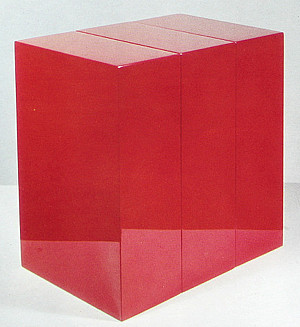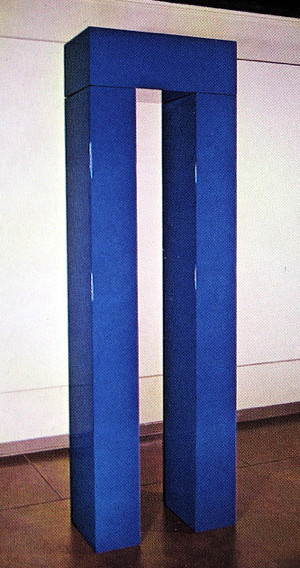FOREWORD TO AN EXHIBITION OF WORKS
BY JOHN McCRACKEN
It is interesting to note that after this show John McCracken made no more such works for about thirty years, devoting his art to more cabalistic matters until the beginning of the 21st Century—when he returned to this early period, making very large, even gigantic, variants of it. (The illustrations here give only the remotest idea of the rich colour and surface of the works.) John McCracken died in 2013, with his work in great demand among the multi-national collectors and dealers.

In bringing John McCracken to Toronto, the Art Gallery of Ontario offers an opportunity to see the work of the most significant sculptor of America’s “second city of art.” Since 1964, the year Henry Geldzahler conferred that title on Los Angeles, McCracken’s development has been remarkable. Then, he was unknown and had barely completed his student period (to which he had come later than most artists). Now, he stands level with the leaders of his generation, the creator of a body of work keyed into the most subtle of contemporary dialectics and yet available to the least sophisticated viewer, as we discovered when his sculpture Love in Italian appeared in the gallery with the Guggenheim International Exhibition in 1968.

To trace McCracken’s development over the last four years is to become increasingly aware of a truth in the paradox that “less is more.” As we watch him gradually isolate the one splendid attribute of surface from all connection with formal drama, we become aware of a destination which nevertheless takes us by surprise—in the form of a plank loafing by the wall in a sun of its own making—a plank as lithe and as incipiently tensed as the surfer poised for his wave. Indeed, a memory of California is inevitably evoked by these works: their formal austerity burgeons with a sensuousness that we have come to associate on the one hand with physical well-being and on the other with, say, the “kustom” car industry—for McCracken not only uses automotive lacquer but is even interested in the possibility of mass production. His work thus adumbrates the “luxe, calme et volupté” of a modern Arcady. As he puts it, “The sculptures are possibly indexes as to how everything (or at least some things) should be.”

The exhibition has been made possible by the kindness of a number of people across the continent. Our gratitude is due first of all to the lenders who with ready generosity have relinquished their beautiful but fragile works in some cases for the second time inside a year. The show would have been impossible without the goodwill and industry on our behalf of Mr. Nicholas Wilder and Miss Katie Bishop of the Nicholas Wilder Gallery in Los Angeles and we are also grateful for the help of Mr. Robert Elkon of the Robert EIkon Gallery in New York. Mr. McCracken is especially to be thanked for putting himself so willingly at our disposal at a time excessively demanding (in the months preceding this exhibition he has had shows in Los Angeles. New York and Paris).
